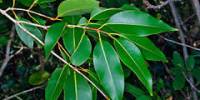INTRODUCTION
Okra (Abelmoschus esculentus) (L.) Moench is a member under Malvaceae family and is also known as Lady’s finger. It is an annual vegetable crop grown from seed in tropical and sub-tropical parts of the world (Tahkur and Arora, 1986).). It is well distributed throughout the Indian sub-continent and East Asia (Rashid, 1990). Its tender green fruits are popular as vegetable among all classes of people in Bangladesh and elsewhere in the world.
Okra is a nutritious and delicious vegetable, fairly rich in vitamins and minerals. Per 100 gm of edible portion of pod have moderate levels of vitamin A (0.01 mg) and C (18 g), calcium (90 mg), phosphorus and potassium. The content of thiamine (0.07 mg), riboflavin (0.08 mg) and niacin (0.08 mg) per 100 g edible portion of pod is higher than that of many vegetables (Rashid, 1990). Tender pods have high mucilage content and are used in soups and gravies. The pods also have some medicinal value and a mucilaginous preparation from the pod can be used as a plasma replacement or blood volume expander.
In Bangladesh vegetable production is not uniform round the year. Vegetables are plenty in winter, but are lower in summer. The total vegetable production, around 30% is produced during kharif season (April to September and 70% is produced in Rabi season (October to March) (Annon., 1993). Though it is popular in the country, its production is mainly concentrated during summer. Total production of okra is about 19210 metric tones produced from 6210.53 hectare of land in the year 2003, and the average yield is about 3.093 t/ha (BBS, 2004), which is very low, compared to that of other developed countries where the yield is as high as 7.0-12.0 t/ha (Yamaguchi, 1998).
Growth and yield of okra depend on nutrient availability in soil, which is related to the judicious application of manures and fertilizers. Nutrient may be applied through two sources viz. organic and inorganic. Increased use of inorganic fertilizer in crop production causes health hazards, Pollute the air, water and soil etc. The continuous use of chemical fertilizer badly affects the soil texture, structure, color, aeration, water holding capacity and microbial activity of soil. A good soil has an organic matter content of more than 3%.But in Bangladesh soil of most region have less than 1.5%,some soil have less than 1% organic matter. For continuous cropping, organic manures applied to the crop fields through cowdung, poultry litter, farmyard manure etc. are insufficient. Now a days, gradual deficiency in soil organic matter and reduce yield of crops are alarming factors and burning issues for the farmers and agriculturists. All efforts should be made to develop consciousness of the farmers about the importance of soil organic matter in the long term maintenance of soil productivity. Kamaluddin (1968) reported that organic manure increases soil organic matter and essential nutrient elements for plants. In recent year livestock farming is increasing. So manure like cowdung etc. is becoming available. Wright (1960) studied that Horse and Cow manure contains approximately 0.5% N, 0.55% K and 0.25 % Phosphoric acid. It thus supplies three of main elements needed by fruit plants.
Considering the above facts, the present research was under taken with the following objectives:
- To study the effect of cowdung as organic sources of nutrient on the growth of okra.
- To know the optimum dose of cowdung this would be better for the growth and yield of okra.
- To find out the possibilities of obtaining better yield instead of using inorganic fertilizer.
MATERIALS AND METHODS
Specific approach requires a close understanding of the subject matter. This paper mainly depends on the secondary data. Different published reports of different journals mainly supported in providing data for this paper. This paper is completely a review paper. Therefore, no specific method has been followed in preparing this paper. It has been prepared by comprehensive studies of various articles published in different journals, books and proceedings available in the libraries of Sher-e-Bangla Agricultural University (SAU), Bangabandhu Sheikh Mujibur Rahman Agricultural University (BSMRAU), Bangladesh Agricultural Research Institute (BARI), Bangladesh Rice Research Institute (BRRI) and Bangladesh Agricultural Research Council (BARC).Valuable information has been also collected through personal contact with some resource personnel and with the help of Internet facilities. After collection of data from the above mentioned sources compilation was done carefully and was arranged systematically for presentation.
RESULT AND DISCUSSION
Okra is one of the most important vegetables in Bangladesh, as well as in the world. Researches on various aspects of its production technology have been carried out worldwide .Among these researches, very few numbers of works were reported where the effect of cowdung was studied. However, some of the researches and their findings related to the present study carried out at home and abroad are reviewed in this study.
The results of the present study have been presented and discussed and possible interpretations have been made under the following headings.
Plant height
Plant height was recorded at 15, 30, and 45 DAS. Different level of Cowdung showed highly significant influence on plant height. At 15 DAS tallest plant height (14.66 cm) was obtained from C3 whereas shortest plant height (6.46 cm) was obtained from control (no manure) treatment. At 30 DAS and 45 DAS, tallest plant height (41.99 cm and 71.66 cm) was obtained from C 3 treatment and shortest plant height (19.28 cm and 40.72 cm) was obtained from control (no manure) treatment.

Fig.1. Effect of different doses of cowdung on plant height at different days after sowing.
Source: Shahnawaz, 2007
Number of leaves per plant
The effect of Cowdung on number per plant at 15 DAS, 30 DAS and 45 DAS was found to be statistically significant. At 15 DAS, 30 DAS and 45 DAS, the maximum number of leaves per plant (4.41 cm, 10.94 cm and 17.71 cm) was recorded from C3 treatment and the minimum number of leaves per plant (3.24 cm, 8.66 cm and 14.09 cm) was recorded from control treatment.

Fig. 2. Effect of different doses of cowdung on number of leaves at different days after sowing.
Source: Shahnawaz, 2007
Leaf length
The effect of Cowdung was significant on leaf length and it was highly significant at 30 DAS. The maximum leaf length at 30 DAS was recorded 16.25 cm from C3 treatment and minimum length was recorded 9.48 cm from control treatment. At 15 DAS and at 45 DAS, C3 treatment showed maximum leaf length (11.29 cm and 18.70 cm respectively ) where as control showed minimum length (6.30 cm and12.74 cm) respectively.
Table. 1: Effect of different doses of cowdung on leaf length of okra at different days after sowing.
Treatment | Leaf length (cm.) | ||
15 DAS | 30 DAS | 45 DAS | |
C0 | 6.30 | 9.48 | 12.74 |
C1 | 8.85 | 12.40 | 15.88 |
C2 | 10.15 | 14.59 | 17.49 |
C3 | 11.29 | 16.25 | 18.70 |
LSD(0.05) | 0.99 | 1.13 | 1.26 |
CV (%) | 4.23 | 4.81 | 4.62 |
Source: Shahnawaz, 2007
Cowdung:
C0: 0 ton /ha
C1: 14 ton /ha
C2: 15.4 ton /ha
C3: 16.8 ton /ha
Leaf Breadth:
Statistically significant result was observed from different level of Cowdung. At 15 DAS, 30 DAS and 45 DAS, the widest leaf (16.11 cm, 22.03 cm and 25.54 cm) was obtained from C3 treatment and the narrowest leaf (9.18 cm, 11.90 cm and 15.47 cm) was obtained from control treatment.
Table .2: Effect of different doses of cowdung on leaf breadth of okra at different days after sowing.
Treatment | Leaf breadth (cm.) | ||
15 DAS | 30 DAS | 45 DAS | |
C0 | 9.18 | 11.90 | 15.47 |
C1 | 12.41 | 16.12 | 19.16 |
C2 | 14.51 | 19.32 | 22.76 |
C3 | 16.11 | 22.03 | 25.54 |
LSD(0.05) | 1.38 | 2.34 | 1.64 |
CV (%) | 6.43 | 3.81 | 3.70 |
Source: Shahnawaz, 2007
Cowdung:
C0: 0 ton /ha
C1: 14 ton /ha
C2: 15.4 ton /ha
C3: 16.8 ton /ha
Petiole length
Cowdung influenced petiole length significantly with its different level. The highest length (7.38 cm, 10.25 cm and 11.29 cm) was obtained from C3 treatment at 15 DAS,30 DAS and 45 DAS respectively where as lowest length (3.37 cm,4.62 cm and 5.66 cm) was obtained from control treatment.
Table. 3: Effect of different doses of cowdung on petiole length of okra at different days after sowing.
Treatment | Petiole length (cm.) | ||
15 DAS | 30 DAS | 45 DAS | |
C0 | 3.37 | 4.62 | 5.66 |
C1 | 4.54 | 6.45 | 7.35 |
C2 | 6.26 | 8.10 | 8.90 |
C3 | 7.38 | 10.25 | 11.29 |
LSD(0.05) | 0.68 | 0.90 | 1.01 |
CV (%) | 4.93 | 4.04 | 3.32 |
Source: Shahnawaz, 2007
Cowdung:
C0: 0 ton /ha
C1: 14 ton /ha
C2: 15.4 ton /ha
C3: 16.8 ton /ha
Plant Diameter
The present study revealed that there was a highly significant effect of organic sources of nutrients on plant diameter of okra at different days after sowing .Cowdung (18 ton/ha) shows (1.32 cm) and control treatment shows (1.23 cm) plant diameter at 20 DAS. At 40 DAS ( 1.90 cm) plant diameter was obtained from cow dung and (1.83 cm) plant diameter was obtained from control treatment. At 60 DAS (2.75 cm) plant diameter was obtained from cow dung and ( 2.65 cm) plant diameter was obtained from control treatment.
Table. 4: Effect of different organic sources of nutrients on plant diameter of okra at different days after sowing.
Treatment | Plant diameter (cm.) | ||
20 DAS | 40 DAS | 60 DAS | |
| No manure (M0) | 1.23 | 1.83 | 2.65 |
| Cowdung (M1) | 1.32 | 1.90 | 2.75 |
Poultry litter (M2) | 1.45 | 2.08 | 2.92 |
| FYM(M3) | 1.43 | 2.05 | 2.86 |
| LSD(0.05) | 0.095 | 0.144 | 0.153 |
| CV (%) | 8.54 | 8.80 | 6.58 |
Source: Akhter, 2007
Organic sources of nutrients:
M0: No manure (control)
M1: Cowdung (18 ton/ha)
M2: Poultry Litter (15 ton/ha)
M3: Farm Yard Manure (16.5 ton/ha)
No. of branches per plant
A highly significant variation was observed in respect of number of branches per plant due to different organic sources of nutrient at different days after sowing. Cowdung (18 ton/ha) shows(1.61) and control treatment shows (1.46) no. of branches at 20 DAS. At 40 DAS (3.48) no. of branches were obtained from cowdung and (3.34) no. of branches were obtained from control treatment. At 60 DAS (3.63)no. of branches were obtained from cowdung and (3.54) no. of branches were obtained from control treatment.
Table.5: Effect of different organic sources of nutrients on no.of branches per plant of okra.
| Treatment |
No. of branches per plant | ||
20 DAS | 40 DAS | 60 DAS | |
| No manure(M0) | 1.46 | 3.34 | 3.54 |
| Cowdung (M1) | 1.61 | 3.48 | 3.63 |
| Poultry litter(M2) | 1.87 | 3.61 | 3.83 |
| FYM (M3) | 1.63 | 3.49 | 3.67 |
| LSD(0.05) | 0.134 | 0.212 | 0.229 |
| CV (%) | 9.74 | 7.31 | 7.54 |
Source: Akhter, 2007
Organic sources of nutrients :
M0: No manure (control)
M1: Cowdung (18 ton/ha)
M2: Poultry Litter (15 ton/ha)
M3: Farm Yard Manure (16.5 ton/ha)
Green pod length
A significant variation was found due to the effect of different Cowdung and Poultry litter.C3 treatment produced maximum green pod length (14.05 cm) and control treatment produced minimum pod length (12.78 cm).
Green pod diameter
From analysis of variance it was observed that the effect of Cowdung and Poultry litter individually or combined was statistically similar. The maximum pod diameter (1.90 cm) was obtained from C3 treatment and minimum pod diameter (1.78 cm) was obtained from control treatment.
Number of green pod per plant
Analysis of variance showed that the effect of Cowdung on number of green pod was highly significant. Among four treatments of Cowdung, maximum number of green pod (15.39) was obtained from C3 treatment and minimum number of pod (11.97) was obtained from control treatment.
Table .6: Effect of different doses of cowdung on pod length, pod diameter and no. of pod per plant of okra.
Treatment | Pod length(cm) | Pod diameter (cm) | No. of Pod plant-1 |
C0 | 12.78 | 1.78 | 11.97 |
C1 | 13.07 | 1.80 | 12.62 |
C2 | 13.75 | 1.83 | 13.06 |
C3 | 14.05 | 1.90 | 15.39 |
LSD(0.05) | 0.86 | 0.11 | 1.48 |
CV (%) | 6.68 | 3.85 | 3.62 |
Source: Shahnawaz, 2007
Cowdung:
C0: 0 ton /ha
C1: 14 ton /ha
C2: 15.4 ton /ha
C3: 16.8 ton /ha
Individual green pod weight
Significant variation was due to the effect of Cowdung on individual green pod weight (Appendix III). The maximum pod weight (16.09g) was obtained from C3 treatment and the minimum pod weight (13.78g) was obtained from control treatment.
Need from control treatment where as the maximum pod weight 16.60 g was obtained from C3P3 treatment though C3P2 and C3P1 treatments were statistically similar.
Green pod yield per plant
Cowdung and Poultry litter showed highly significant variation on the green pod yield per plant (Appendix III). The maximum green pod yield per plant (247.91g) was recorded from C3 treatment and minimum green pod yield per plant (165 g) was recorded from control treatment.
Green pod yield per plot
From the analysis of variance it was found that the effect of Cowdung and Poultry litter, individually or combined on yield per plot was highly significant.C3 treatment gave the highest yield (2.98 kg) and control treatment gave the lowest yield per plot (1.98 kg).
Table. 7: Effect of different doses of cowdung on pod weight, yield per plant, yield per plot of okra.
Treatment | Pod weight (g) | Yield Plant-1 (g) | Yield Plot-1 (kg) |
C0 | 13.78 | 165.00 | 1.98 |
C1 | 14.99 | 189.44 | 2.27 |
C2 | 15.73 | 204.65 | 2.46 |
C3 | 16.09 | 247.91 | 2.98 |
LSD(0.05) | 0.86 | 25.72 | 0.31 |
| CV (%) | 3.43 | 7.65 | 7.65 |
Source: Shahnawaz, 2007
Cowdung:
C0: 0 ton /ha
C1: 14 ton /ha
C2: 15.4 ton /ha
C3: 16.8 ton/ha
Green pod yield per hectare
Cowdung and Poultry litter showed highly significant variation on the green pod yield per hectare. The maximum green pod yield per hectare (8.30 tons) was recorded from C3 treatment whereas, the lowest pods yield (5.51 tons) was obtained from control treatment.

Fig. 3:Yield of Okra at different doses of cowdung (t/h)
Source: Shahnawaz, 2007
Cowdung:
C0: 0 ton /ha
C1: 14 ton /ha
C2: 15.4 ton /ha
C3: 16.8 ton /ha
Number of days to first flowering
Different organic sources of nutrients exhibited no significant influences on the number of days to first flowering. The plant with cowdung showed early (42.82 days) flowering and control treatment showed dalay (42.99 days) flowering.
Table.8: Effect of different organic sources of nutrients on no. of days to first flowering of okra.
| Treatment | No. of days to first flowering |
| No manure( M0) | 42.99 |
| Cowdung ( M1) | 42.82 |
Poultry litter (M2) | 42.26 |
| FYM (M3) | 42.59 |
| LSD(0.05) | 2.193 |
| CV (%) | 3.08 |
Source: Akhter, 2007
Organic sources of nutrients:
M0: No manure (control)
M1: Cowdung (18 ton/ha)
M2: Poultry Litter (15 ton/ha)
M3: Farm Yard Manure (16.5 ton/ha)
Attractiveness
Attractiveness of okra green pod was estimated in score by eye estimation with 10 to1 scale (most attractive to less attractive). Attractiveness of okra green pod was influenced by color, size, shape and free from blemices. So in case of numbering color, size and shape was considered. Highly significant variation in score was observed among the organic sources of nutrients. Cowdung produced attractive green pods (score 6.10) and less attractive green pods (score 5.78) were produced from control treatment.
Tenderness
Tenderness is one of the most important qualitative characters for green okra in the consumers market. The tenderness of green pod was influenced by the organic sources of nutrients. Tenderness of green pods was estimated in a 10 to1 scoring scale (tender to hard). The most (score 5.83) tender green pod was produced from cowdung and less tender green pod (score 5.51) was produced from control treatment.
Shelf life
Storage ability of okra green pod is an important qualitative character. Storage ability of okra green pods treated with different organic sources of nutrients showed highly significant difference. Storage ability was measured in days up to which the pod remained in marketable condition. Higher storage ability (score 3.34) of okra was observed from cowdung and the minimum storage ability (score3.25) was observed from no manure (control treatment).
Table.9: Effect of different organic sources of nutrients on attractiveness, tenderness, shelf life of okra.
| Treatment | Attractiveness | Tenderness | Shelf life |
| No manure (M0) | 5.78 | 5.81 | 3.25 |
| Cowdung (M1) | 6.10 | 5.83 | 3.34 |
| Poultry Litter(M2 ) | 6.59 | 5.88 | 3.58 |
| FYM (M3 ) | 6.35 | 5.85 | 3.79 |
| LSD(0.05) | 0.053 | 0.316 | 0.303 |
| CV (%) | 4.88 | 3.28 | 5.35S |
Source: Akhter, 2007
Organic sources of nutrient :
M0: No manure (control)
M1: Cowdung (18 ton/ha)
M2: Poultry Litter (15 ton/ha)
M3: Farm Yard Manure (16.5 ton/ha)
Green pod yield per hectare
Different organic sources of nutrients showed ahighly significant variation on the green pod yield per hectare. Cowdung shows better (8.26 tons) green pod yield per hectare whereas control treatment shows the lowest (6.75 tons) greenpod yield.

Fig.4.Effect of different organic sources of nutrients on green pod yield per hectare.
Source: Akhter, 2007
Organic sources of nutrients:
No manure (control)
Cowdung (18 ton/ha)
Poultry Litter (15 ton/ha)
Farm Yard Manure (16.5 ton/ha)
CONCLUSIONThis study is laid to evaluate the effects of different levels of cowdung on the growth and yield of okra.
Different levels of cowdung significantly influenced all parameters. It was observed that cowdung applied at 16.8 ton/ha increased the plant height, number of leaves, leaves length, leaves breadth, petiole length which was significantly different from at, 15 DAS, 30 DAS and 45 DAS. It was revealed that cowdung application at 16.8 ton/ha also influenced the Green pod length, green pod diameter, number of green pod per plant, green pod yield/plot, green pod yield/ha, which were significantly different from all other treatment levels.
The maximum plant height 71.66 cm, number of leaves 17.71, petiole length 11.29 cm, leaves length 18.70 cm, leaves breadth 25.54 cm were found from the plants receiving 16.8 ton cowdung /ha at 45 DAS and the maximum green pod yield, 2.98 kg/plot and maximum green pod yield, 8.30 ton/ha were found from the plants receiving 16.8 ton cowdung /ha. Again18 ton cowdung/ha shows lower yield than 16.8 ton cowdung/ha.
The minimum plant height 40.72 cm, number of leaves14.09, petiole length 5.66 cm, leaves length,12.74 cm, leaves breadth 15.47 cm, were found from the plant receiving 0 kg cowdung /ha at 45 DAS respectively and the minimum green pod yield 1.98 kg/plot and green pod yield 5.51 ton/ha were recorded from control treatment (0 kg cowdung /ha).
So, 16.8 ton cowdung /ha is an important dose for better growth and development of okra.
















